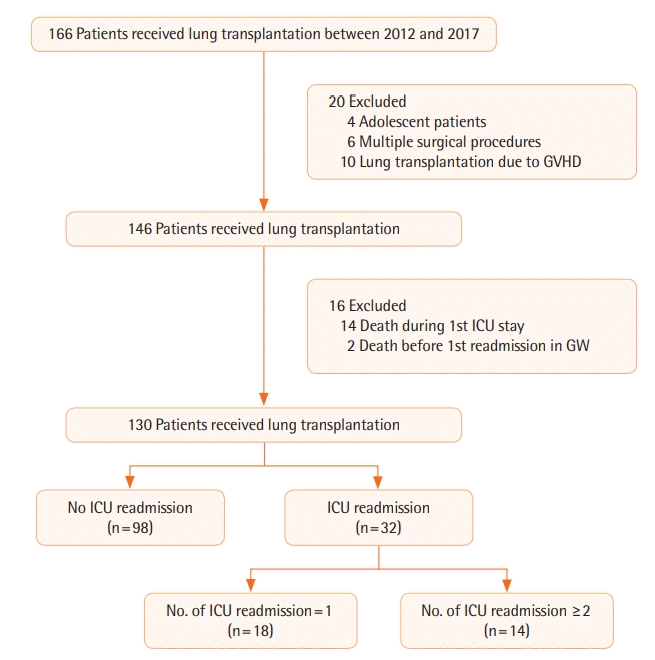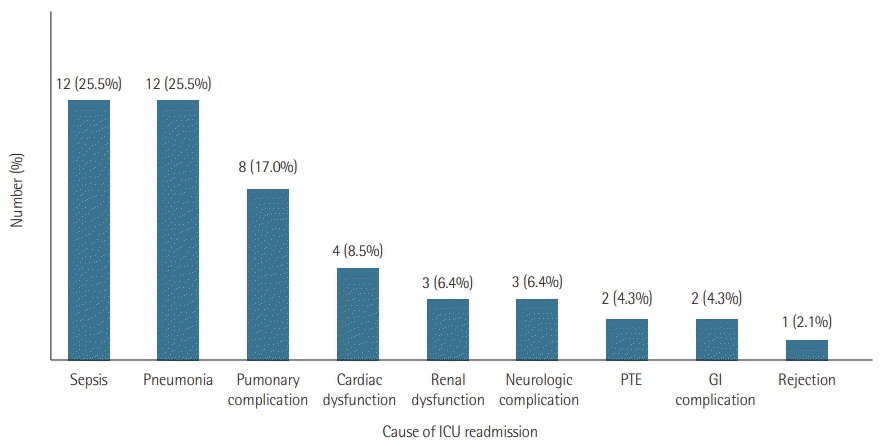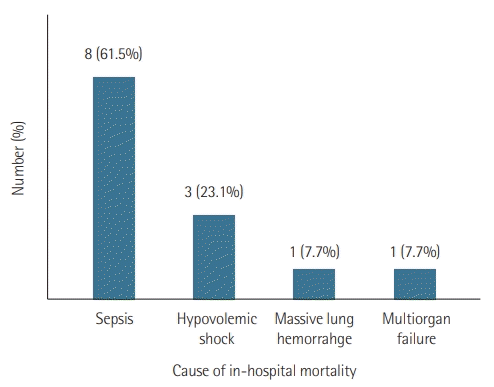INTRODUCTION
MATERIALS AND METHODS
Study Protocol
Data Collection
Statistical Analysis
RESULTS
Table 1.
| Variable | Total (n=130) |
Readmission |
P-value | |
|---|---|---|---|---|
| No (n=98) | Yes (n=32) | |||
| Age (yr) | 56 (47−62) | 55 (45−60) | 62 (53−65) | 0.003* |
| Male sex | 77 (59.2) | 54 (55.1) | 23 (71.9) | 0.103 |
| Body mass index (kg/m2) | 23.1 (19.9−30.9) | 22.6 (19.8−30.7) | 23.4 (20.3−30.9) | 0.929 |
| Hypertension | 24 (18.5) | 17 (17.3) | 7 (21.9) | 0.603 |
| Diabetes mellitus | 24 (18.5) | 15 (15.3) | 9 (28.1) | 0.120 |
| Coronary artery occlusive disease | 11 (8.5) | 8 (8.2) | 3 (9.4) | >0.999 |
| Atrial fibrillation/flutter | 5 (3.8) | 5 (5.1) | 0 | 0.333 |
| Chronic kidney disease | 1 (0.8) | 0 | 1 (3.1) | 0.246 |
| Liver cirrhosis | 6 (4.6) | 4 (4.1) | 2 (6.2) | 0.636 |
| LVEF (%) | 64±7 | 64±7 | 64±10 | 0.847 |
| Pulmonary hypertension | 85 (65.4) | 62 (63.3) | 23 (71.9) | 0.402 |
| FVC (% predicted) | 41±15 | 39±15 | 46±17 | 0.059 |
| FEV1 (% predicted) | 43 (29−53) | 41 (28−50) | 51 (37−59) | 0.013* |
| FEV1/FVC | 86 (79−91) | 86 (79−92) | 86 (78−89) | 0.815 |
| DLCO (% predicted) | 29 (23−39) | 29 (23−39) | 30 (21−35) | 0.901 |
| Home oxygen therapy | 81 (62.3) | 59 (60.2) | 22 (68.8) | 0.411 |
| ECOG performance status | 0.197 | |||
| 0 | 1 (0.8) | 1 (1) | 0 | |
| 1 | 52 (40) | 44 (44.9) | 8 (25) | |
| 2 | 17 (13.1) | 13 (13.3) | 4 (12.5) | |
| 3 | 39 (30) | 27 (27.6) | 12 (37.5) | |
| 4 | 21 (16.2) | 13 (13.3) | 8 (25) | |
| Level of education | 0.024* | |||
| Middle school graduate or lower | 28 (21.5) | 16 (16.3) | 12 (37.5) | |
| High school graduate or higher | 102 (78.5) | 82 (83.7) | 20 (62.5) | |
| Diagnosis | 0.362 | |||
| Idiopathic pulmonary fibrosis | 98 (75.4) | 76 (77.6) | 22 (68.8) | |
| Bronchiolitis obliterans | 10 (7.7) | 7 (7.1) | 3 (9.4) | |
| COPD | 8 (6.2) | 6 (6.1) | 2 (6.3) | |
| Bronchiectasis | 6 (4.6) | 4 (4.1) | 2 (6.3) | |
| PPH | 2 (1.5) | 0 | 2 (6.3) | |
| Lymphangioleiomyomatosis | 3 (2.3) | 2 (2) | 1 (3.1) | |
| Acute interstitial pneumonia | 2 (1.5) | 2 (2) | 0 | |
| Destroyed lung due to pulmonary tuberculosis | 1 (0.8) | 1 (1) | 0 | |
| Transplantation type | 0.022* | |||
| Bilateral | 122 (93.8) | 95 (96.9) | 27 (84.4) | |
| Unilateral | 8 (6.2) | 3 (3.1) | 5 (15.6) | |
Values are presented as median (interquartile range), number (%), or mean±standard deviation.
ICU: intensive care unit; LVEF: left ventricular ejection fraction; FVC: forced vital capacity; FEV1: forced expiratory volume in 1 second; DLCO: diffusing capacity for carbon monoxide; ECOG: Eastern Cooperative Oncology Group; COPD: chronic obstructive pulmonary disease; PPH: primary pulmonary hypertension.
Table 2.
Table 3.
| Variable | Total (n=130) |
Readmission |
P-value | |
|---|---|---|---|---|
| No (n= 98) | Yes (n=32) | |||
| Preoperative data | ||||
| Preoperative intubation | 36 (27.7) | 22 (22.4) | 14 (43.8) | 0.024* |
| Preoperative ECMO | 18 (13.8) | 14 (14.3) | 4 (12.5) | >0.999 |
| WBC (/mm3) | 9,465 (7,222−1,2560) | 9,575 (6,928−12,158) | 8,910 (7,675−13,968) | 0.638 |
| Neutrophil (%) | 75 (67−87) | 74 (66−86) | 76 (67−89) | 0.301 |
| Hemoglobin (g/dl) | 12.5±2.4 | 12.5±2.4 | 12.5±2.6 | 0.951 |
| Platelet (×103/mm3) | 215 (32−282) | 218 (133−282) | 210 (125−264) | 0.511 |
| Creatinine (mg/dl) | 0.60 (0.45−0.72) | 0.6 (0.46−0.72) | 0.55 (0.44−0.8) | 0.787 |
| Albumin (g/dl) | 3.4 (2.8−4.0) | 3.5 (2.9−4.0) | 3.1 (2.5−3.6) | 0.015* |
| Intraoperative data | ||||
| Operation time (min) | 371 (341−429) | 365 (339−425) | 391 (359−445) | 0.196 |
| Fluid administration (ml) | 7,075 (5,288−9,263) | 7,054 (5,288−8,663) | 7,525 (5,050−11,288) | 0.270 |
| Urine output (ml) | 1,090 (673-1,951) | 1,048 (609-1,798) | 1,173 (753-3,084) | 0.260 |
| Estimated blood loss (ml) | 1,950 (1,000−3,300) | 1,755 (956−3,038) | 2,325 (1,575−3,425) | 0.064 |
| Transfusion (unit) | ||||
| Red blood cell | 6 (4−9) | 6 (4−9) | 7 (4−10) | 0.274 |
| Fresh frozen plasma | 3 (0−5) | 3 (0−5) | 3 (1−3) | 0.862 |
| Platelet concentrate | 5 (0−6) | 5 (0−8) | 6 (0−6) | 0.866 |
Table 4.
| Variable | Total (n=130) |
Readmission |
P-value | |
|---|---|---|---|---|
| No (n= 98) | Yes (n=32) | |||
| SOFA score | 3 (2−4) | 3 (2−4) | 4 (3−6) | 0.016* |
| Heart rate (bpm) | 98±15 | 98±13 | 96±20 | 0.516 |
| Mean arterial pressure (mm Hg) | 93±12 | 94±11 | 92±13 | 0.625 |
| SpO2 (%) | 100 (98−100) | 100 (98−100) | 100 (98−100) | 0.585 |
| Body temperature (°C) | 36.6 (36.5−37.0) | 36.6 (36.5−37.0) | 36.6 (36.5−37.1) | 0.922 |
| pH | 7.454 (7.417−7.481) | 7.460 (7.431−7.482) | 7.446 (7.371−7.465) | 0.012* |
| PaCO2 (mm Hg) | 36 (31−42) | 35 (30−41) | 39 (33−45) | 0.051 |
| PaO2 (mm Hg) | 113 (93−140) | 110 (93−137) | 124 (95−152) | 0.262 |
| P/F ratio | 281 (215−359) | 280 (217−355) | 294 (202−365) | 0.820 |
| WBC (/mm3) | 11,240 (7,970−14,580) | 11,545 (8,245−14,580) | 10,490 (7,750−14,440) | 0.581 |
| Neutrophil (%) | 91.3 (88.5−93.3) | 91.4 (88.5−93) | 91.3 (87.6−93.7) | 0.967 |
| Hemoglobin (g/dl) | 10.1 (9.3−11.0) | 10.2 (9.5−11.0) | 9.6 (9.0−11.1) | 0.228 |
| Platelet (×103/mm3) | 158 (115−232) | 159 (118−243) | 123 (107−201) | 0.259 |
| Creatinine (mg/dl) | 0.43 (0.32−0.62) | 0.42 (0.32−0.59) | 0.52 (0.39−0.85) | 0.049* |
| Albumin (g/dl) | 3.1±0.3 | 3.1±0.3 | 3.0±0.3 | 0.037* |
| MV duration (hr) | 126 (70−288) | 110 (65−273) | 179 (87−349) | 0.072 |
| Reintubation | 21 (16.2) | 13 (13.3) | 8 (25) | 0.164 |
| Tracheostomy | 53 (40.8) | 34 (34.7) | 19 (59.4) | 0.014* |
| Rehabilitation | 66 (50.8) | 49 (50.0) | 17 (53.1) | 0.759 |
| ICU LOS (day) | 8 (6−15) | 8 (6−12) | 10 (6−23) | 0.017* |
Values are presented as median (interquartile range), mean±standard deviation, or number (%).
ICU: intensive care unit; SOFA: Sequential Organ Failure Assessment; SpO2: peripheral oxygen saturation; PaCO2: arterial carbon dioxide partial pressure; PaO2: arterial oxygen partial pressure; P/F ratio: the ratio of arterial oxygen partial pressure to fractional inspired oxygen; WBC: white blood cell; MV: mechanical ventilation; LOS: length of stay.
Table 5.
| Variable |
Univariable |
Multivariable (unadjusted) |
Multivariable (adjusted)a |
|||
|---|---|---|---|---|---|---|
| OR (95% CI) | P-value | OR (95% CI) | P-value | OR (95% CI) | P-value | |
| SOFA score | 1.547 (1.164−2.056) | 0.003* | 1.464 (1.083−1.978) | 0.013* | 1.527 (1.065−2.190) | 0.021* |
| pHb | 0.885 (0.815−0.960) | 0.003* | 0.884 (0.813−0.962) | 0.004* | 0.843 (0.764−0.929) | 0.001* |
| PaCO2 | 1.044 (1.003−1.087) | 0.035* | ||||
| Creatinine | 1.788 (0.865−3.695) | 0.117 | ||||
| Albumin | 0.222 (0.051−0.964) | 0.045* | 0.267 (0.055−1.302) | 0.102 | 0.311 (0.050−1.190) | 0.207 |
| MV duration | 1.001 (1.000−1.002) | 0.149 | ||||
| Tracheostomy | 2.751 (1.213−6.240) | 0.015* | ||||
| ICU LOS | 1.056 (1.013−1.100) | 0.010* | ||||




 PDF
PDF Citation
Citation Print
Print






 XML Download
XML Download